For the last fifteen years, I’ve used “clicker training” on almost every animal that I’ve had any interaction with – dogs, chickens, fish, goats, children and even a husband. It’s a generous and effective perspective. You think through what you want, break that down to the smallest doable bit, mark the moment that the behavior happens and reward it. There’s no yelling, punishment or bribing. You work from Yes, that’s it, thank you! to the next step.
The clicker part of it comes from what is commonly used as the marker (also called a bridge signal) that lets the learner know that what they’re doing is right. The marker can be anything that is clear and distinct, like a whistle, a word, a hand signal, or a splash in water (for a fish), but most people use a small box with a tab of metal that makes a sharp click noise when pressed. This noise maker is called a clicker, hence the term, clicker training.
The click is simply a way to communicate I like that! After the click, you reward. This is why this sort of training is called positive reinforcement, the term positive here means addition (like the science symbol +, in fact, it’s often abbreviated as R+). Usually, what’s added is food, but depending on the animal, it could be scratches, or access to grass, or a friend, or freedom to gallop (or, with humans, praise and clear information that they’ve accomplished their task.) Done correctly, the learner knows the exact moment that they did the right thing, and also knows that that behavior will give them something good. This leads to an enthusiastic and engaged learner, which is exactly what you want when training a horse, to, for example, do an extended trot with the sort of energy that turns heads. However, clicker training done without skill or without an understanding of how and why the animal is learning can get a trainer into trouble, especially when working with a big and dangerous animal like a horse.
Think of it this way: the click is like the snap of a camera’s shutter. What you capture at that moment is what the horse will do again. Exactly that. The entire picture. Too often, a trainer focuses on only one corner of that photograph. For example, she clicks when the horse tucks his nose and is delighted that the the horse has posed pretty. But she wasn’t looking at the rest of the body. If, at the same time that the horse tucked, he also hollowed his back, swished his tail, and “let down” (that’s when the penis comes out of the sheath) the horse thinks that all of those things were what she wanted. How was he to know it was just the nose tuck? Reward that entire picture a few times and now you have a pretty nose, but three other things you have to go back and fix.
Here’s an example of how it can go wrong in a scary way. Let’s say that you’re training the horse to step over a pole on the ground. It looks easy enough to you but perhaps your horse has been afraid of cavaletti exercises, so you are using the clicker to encourage him. Let’s say you lead him up to it and he swerves away, so you try again and this time he goes over the pole. You click thinking that you’re encouraging your horse, however when you clicked he was still fearful, he threw his head in the air and he rushed forward. You turn around and repeat the exercise, believing that you had communicated that going over the pole was a good thing to do. Actually, you let him know that rushing the pole was a good thing to do. So, this next time he surges forward, jerking his head and pulling the rope from your hand. He’s not being bad. He’s doing what he thinks you want. Click for that behavior again (because he did, after all, go over the pole) and in short order you’ll have a horse who is trained to dangerously charge over jumps. It’ll take weeks to undo the training that you did in five minutes.
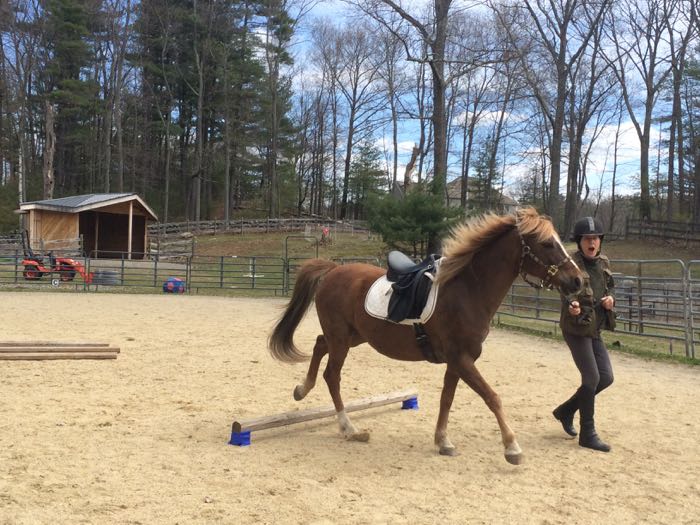
But this doesn’t mean that clicker training is the wrong thing to do! What it does mean is that you have to be very, very clear about the goal behavior and equally thoughtful about all of the steps to get there. The goal behavior in this cavaletti example isn’t as simple as go over the pole. It’s walk next to and in time with handler, with a calm demeanor, and step over the poles without touching them. In the case of this nice little chestnut Morgan, Hayden, he had anxiety about going over poles that are raised, even an inch, above the ground. I observed that what really worried him was touching them with his hind legs. I also observed that the rushing and tension began before the pole. I couldn’t reach my goal while starting with the raised pole. Not if I wanted that goal of a relaxed attitude.
My training philosophy is The slower you go, the faster you get there.
Since even seeing the slightly raised pole riled him up, I backtracked to a place that was calm. I had his owner, Susan, walk elsewhere in the ring, and I clicked and rewarded for this nice relaxed yet forward walk.
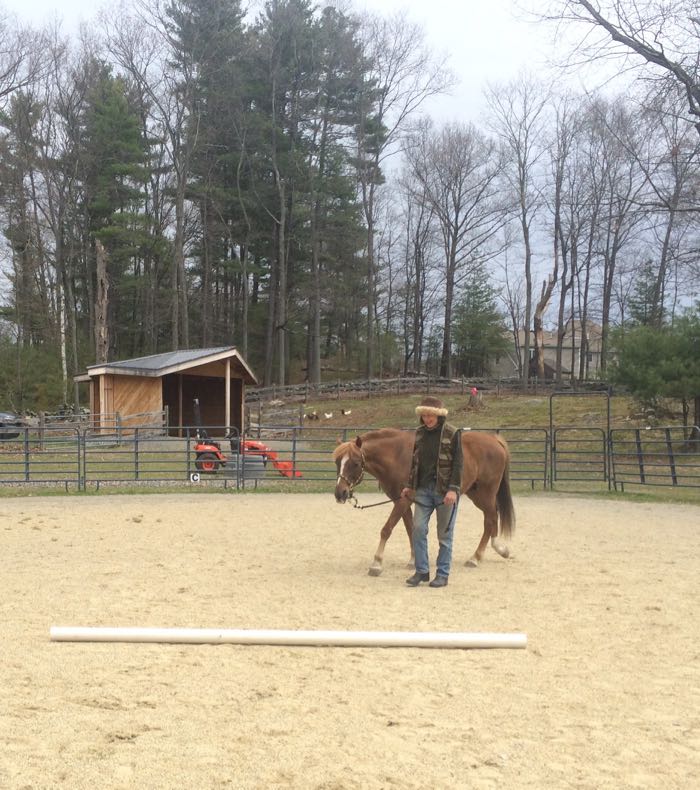
Then she led Hayden over a pole. The wooden poles on the ground aren’t a big deal for him, which is exactly why I wanted to work with them before going back to the raised pole. I was precise here, and, knowing that it was his rear end that he was concerned about, marked the moment that his hind legs were calmly stepping over. His backward ears shows he’s paying attention to those hind hooves, but the rest of his body language conveys that he understands that a steady rhythm and a relaxed way of going earns the click. (Those ears are not pinned. If they were, I’d change this exercise to make it less challenging.)

This white pole was more worrisome to Hayden than the wood poles, so I rewarded for a steady walk up to the pole. Soon, instead of rushing, he carefully stepped over, remaining in rhythm with his owner’s stride.
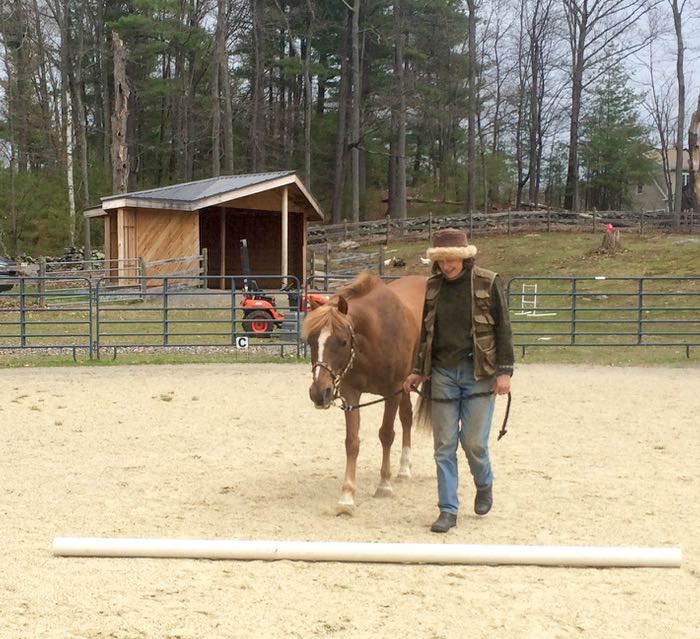
Next I had him walk over a wooden pole still on the ground with the blue supports on either side. You never know if the addition of something visual will cause anxiety. It’s best to create a situation that the horse will succeed in. The first time through Hayden did eyeball those blue supports. I didn’t click, even though he walked between them – because that would have confirmed his worry over the blocks. Too often a trainer will reward nervousness, which actually trains the horse to be tense. I had Susan walk through again, and this time I clicked and rewarded at the moment that he was walking straight ahead, which reinforced the message that it’s calm, forward motion that we want. You could almost see his relief. It’s exhausting being on guard, and here I was telling him that he didn’t have to be!
Next, the pole was put on the support. First only one side was raised up. He walked over. (I don’t have photos of him stepping over because my primary job here was teaching and training. Sorry!)
Then the other end was put up. This was challenging for him, so as he approached it I clicked and rewarded for a calm demeanor. He then stepped over the raised pole as if it wasn’t a big deal at all. Hayden understood that what we were doing was relaxed leading and that the obstacles underfoot were inconsequential. Also, by going slowly like this, he learned that he was capable of picking up his feet, and if, by chance, his toe rapped on the pole, nothing bad would happen.

Doing clicker training from the saddle is even more complicated. There’s a lot going on under you. You might think that you’re clicking for a soft mouth, but you might also be clicking when the haunches are swung out incorrectly. The beauty of the clicker is that it’s precise and effective. What you click for is what you get. But that can also create problems. Dog trainers have many amusing stories of thinking that they’re clicking for one thing, but actually training another. Although that can be cute with a fifteen pound dog who has learned to spin on the way out the door, it’s dangerous with a thousand pound horse. You can’t see the whole picture when you’re riding – you have to feel when it’s right – and that takes years of experience. Even the best riders rely on a trainer who watches and advises from the ground. But, that said, it is possible to improve both attitude and way of going by combining clicker training with tradition horsemanship. Hayden and Susan are perfect examples of that.
Here’s Hayden back in February not long after I started working with him. He’s well-behaved and does as asked, but he’s also hollow behind the saddle, hesitant to reach forward from his hind legs, and not particularly cheerful about the work.
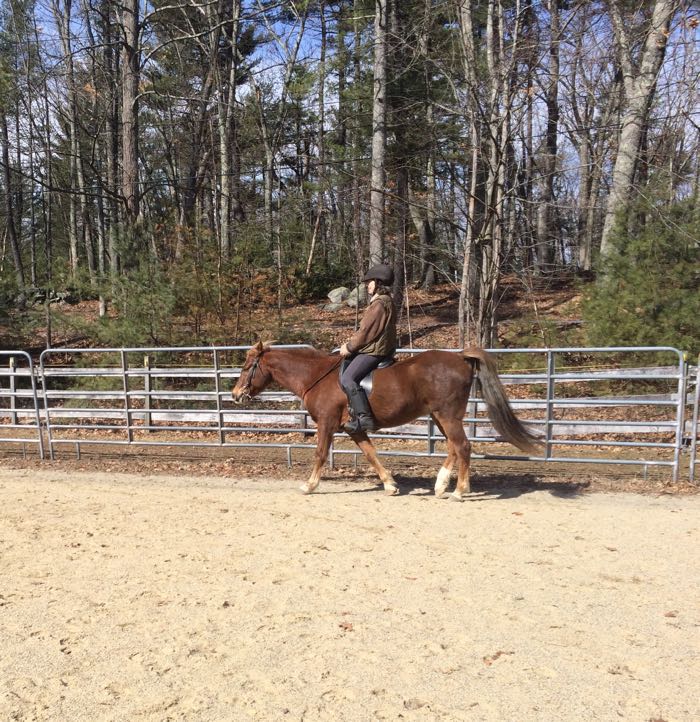
And here he is now, balanced, eager and confident.
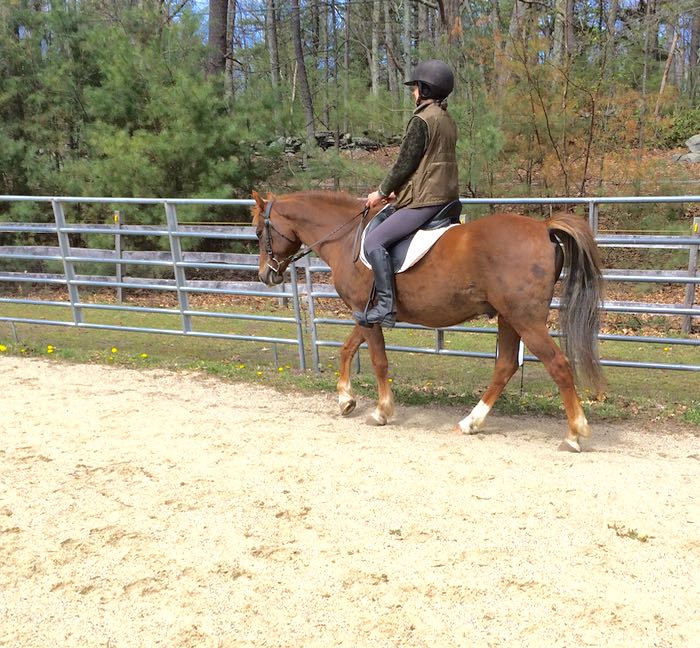
With riding, it’s not just the horse who needs clear directions and rewards, but also the rider. I’ve fine-tuned Susan’s position, balance and effectiveness, all with R+. Susan’s reward though, isn’t edible, it’s that feel when her horse goes happily in sync with her.
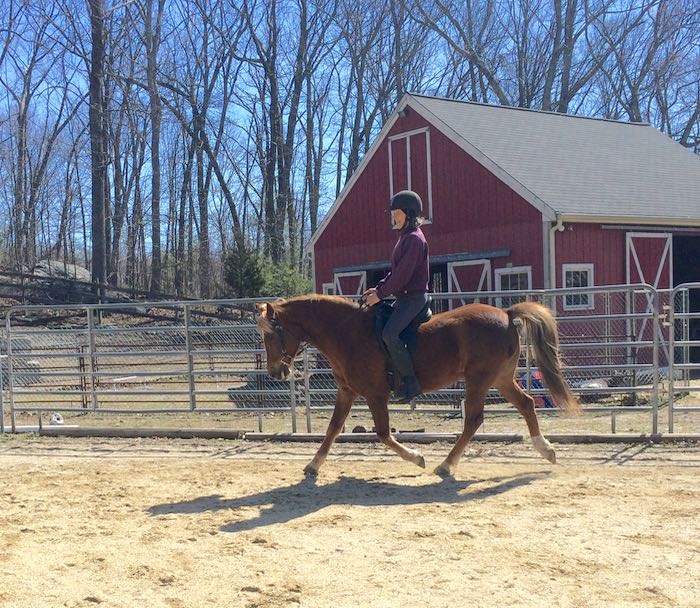


Very informative, well written and thought through blog. It shows that patience is always rewarded, I wish that everyone would learn your way, but sadly many are in to much of a rush and punish rather than reward. Thank you for trying to get across how it should be done. Wonderful can’t praise enough…:)
Thanks, Jan!
Really well put. Its so much harder to get the timing right than people realise, me included.
Thank you
Timing is hard! Practice with behaviors that aren’t going to turn dangerous. Even better, practice with other species.
Yeah, I’d like to read that post about using clicker training on the husband… 🙂
It’s more bringing this perspective to the relationship. Steve loves me and wants to do the right thing. If he’s not, then it’s likely because I haven’t explained what the task is – or it’s something that he can’t do. So, just like with the horses, I think through the behavior, break it down to something that I can reward, and build up to the end task. Then, when he does do whatever it is that I’ve asked for, I show my appreciation. “Thank you” and “I appreciate that” go a long way 🙂